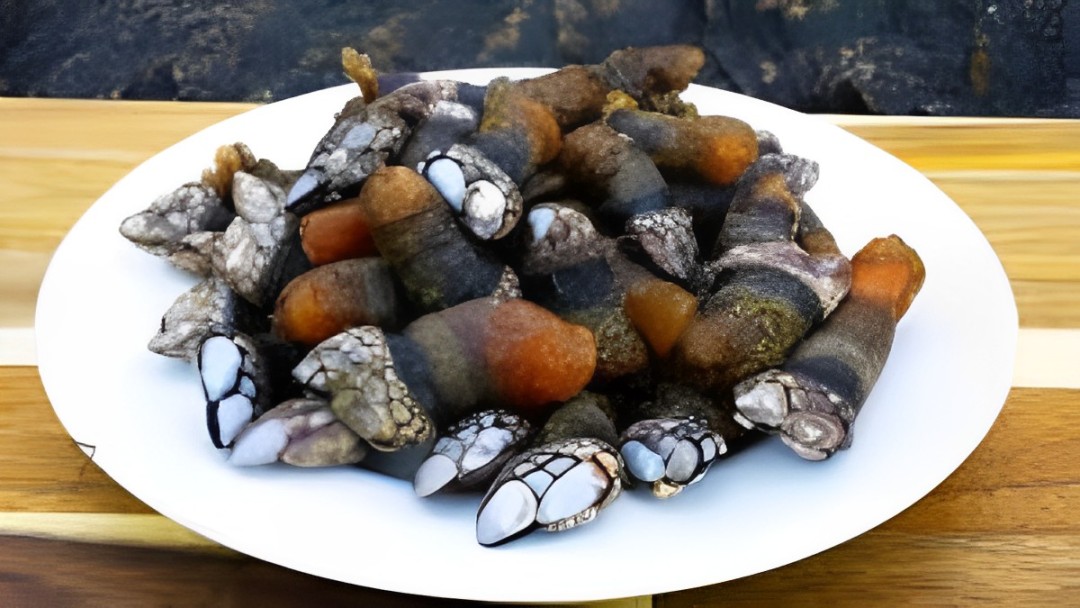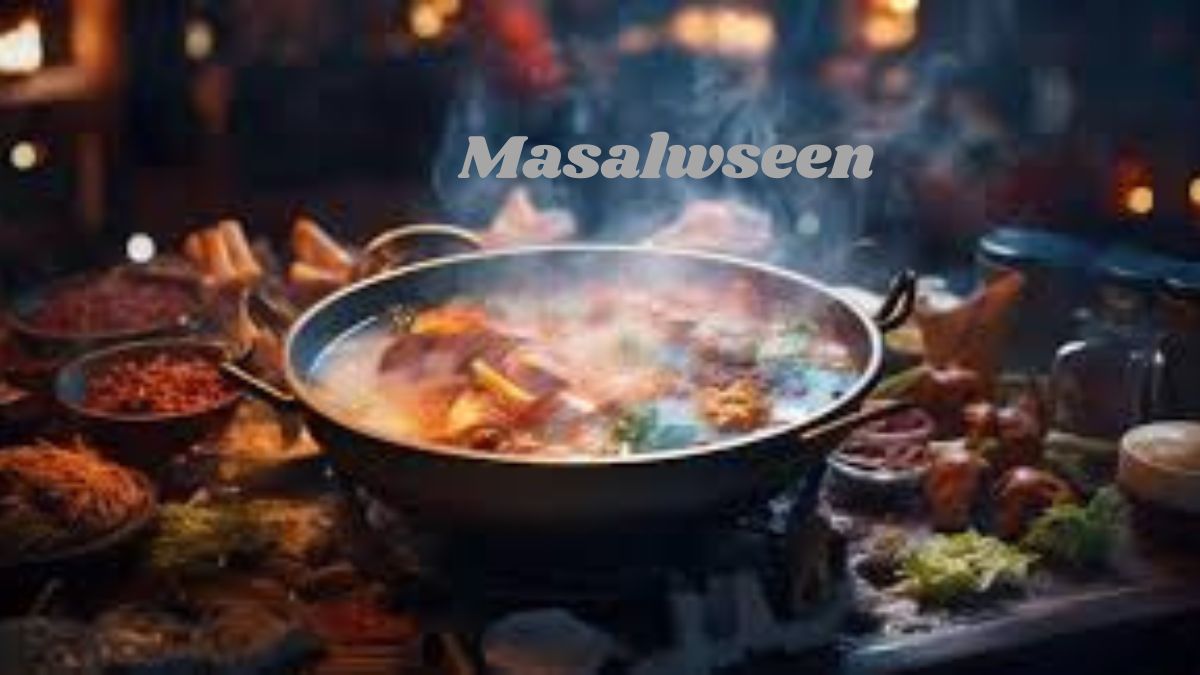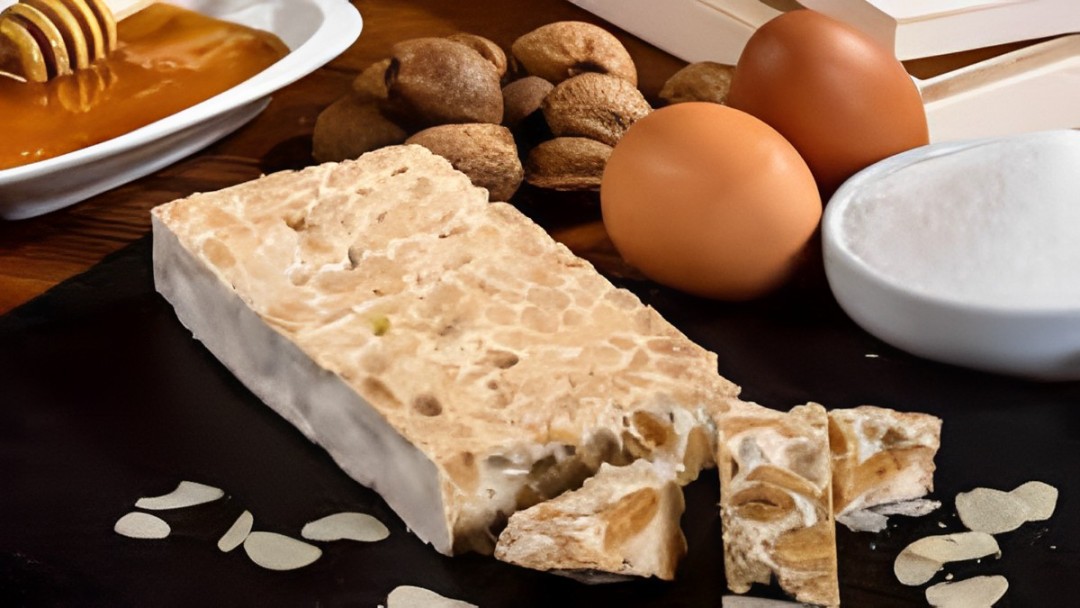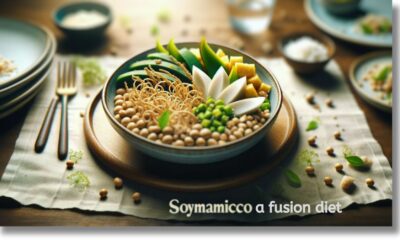Food
“Exploring the Culinary Wonders of Percebes: Braving the Elements for a Taste of the Sea”

Introduction to Percebes
Goose barnacles, sometimes referred to as peribes, are an extremely valuable and uncommon delicacy that are collected from rocky shorelines in coastal areas, especially in the chilly Atlantic Ocean. Pescebes are a delicacy that are known for their distinct texture and saline flavor. They are also an impressive gastronomic experience that showcase the courage and expertise of the fishermen that collect them. Percebes are dangerous plants that cling to rocks in the middle of raging waves and hazardous terrain. Gathering them is an adventurous task that calls both skill and bravery. Notwithstanding these difficulties, percebes’ appealing qualities have drawn seafood connoisseurs from all over the world, elevating them to the status of a premium element in upscale dining establishments and a representation of the rich cultural legacy of coastal places.
The History of Percebes
Around the world, coastal towns have a rich history with percebes, or goose barnacles, especially in areas with rocky shorelines like Galicia, Spain. Although its precise origins are unknown, percebes have been collected for ages by experienced fishermen who brave dangerous waters to obtain these highly valued treats. Percebes are now considered a gastronomic delicacy, honored in festivals, and seen as a symbol of the enduring bond between humans and the sea because of their distinct flavor and the audacity needed to harvest them.
Percebes Harvesting Techniques
Gathering percebes is a risky endeavor that calls for courage, expertise, and a thorough knowledge of the waters. The brave fishermen known as percebeiros risk their lives to reach the rocky outcrops where the clusters of percebes are perched by navigating dangerous beaches and fighting against smashing waves. With just a sharp knife and some ropes, they gently chip away at the rocks to retrieve the valuable shellfish. The timing is critical because they have to move quickly to collect as many percebes before the water level rises once more. The harvest displays human resourcefulness and tenacity, demonstrating the long-lasting relationship between coastal settlements and the abundance of the sea.
The Culinary Delight of Percebes
Goose barnacles, or percebes, provide a unique culinary experience. Preferred for their strong, sea-inspired flavor, percebes are harvested on the rocky coastlines of coastal places, especially in Galicia, Spain. Their distinct flavor, frequently compared to a mix of crab and lobster, makes them a sought-after treat for lovers of seafood. Percebes are a simple tapa that are served fresh after being boiled, and they go well with a crisp white wine or cold beer. The culinary thrill of percebes, which showcases the skill and bravery of the fisherman who brave the weather to bring these gems of the sea to the table, continues to attract diners worldwide despite the obstacles of their precarious harvest.
Percebes Conservation Efforts
In order to maintain the sustainability of this highly valued delicacy, conservation activities for Percebes are essential. Establishing marine protected zones and encouraging ethical harvesting methods are crucial steps in the face of impending dangers including pollution, climate change, and overfishing. With the goal of preventing overexploitation, these programs seek to protect the ecosystems that support Pericebes. The necessity of protecting coastal habitats and the biodiversity they support is also greatly underscored by education and awareness initiatives. By carrying out these conservation initiatives, we may contribute to preserving the delicate balance of our marine habitats and ensuring the survival of Percebes for future generations.
Health Benefits of Percebes
Goose barnacles, or percebes, are not only delicious to eat but also have health advantages. Packed with of vital elements including iron, zinc, and B12, as well as protein, pericebes support general health. Their high protein content helps to maintain and repair muscles, while vitamin B12 helps to support neurological function and the generation of red blood cells. Pericebes are also a good source of iron, which is essential for the body’s oxygen transport, and zinc, which is important for immune system function and wound repair. Percebes can enhance nutrient content and support optimum health when included in a balanced diet.
Popular Percebes Dishes Around the World
Goose barnacles, also known as peribes, are highly valued for their distinct texture and saline flavor, which makes them a popular element in many different cuisines across the globe. They are frequently eaten in Spain just boiled and served as tapas, to go with a crisp white wine. Pericebes are used in traditional Portuguese seafood stews, such as caldeirada, to give the meal a deeper, richer flavor.Pericebes can be featured in creative dishes like ceviche or sushi at high-end restaurants all throughout the world, where their unique flavor can really come through. No matter how they’re cooked, pericebes are still a favorite among seafood lovers worldwide.
Tips for Buying and Storing Percebes
Look for pericebes with securely closed shells, vivid color, and freshness when purchasing them. Steer clear of any probes that seem broken or smell bad. If at all feasible, buy them straight from a respectable fishmonger or high-quality seafood shop.It’s recommended to store percebes cold in the refrigerator until you’re ready to utilize them. To keep them fresh, place them on a bed of ice or in a container with holes in it. Keep them dry and away from water to prevent suffocation and premature deterioration. Percebes taste and texture are best enjoyed as soon as possible after purchase.
Percebes in Culture and Traditions
In the customs and culture of coastal villages, especially in areas such as Galicia, Spain, peribes are highly esteemed. Harvesting pericebes has long been a vital part of the local identity, serving as both a source of income and a way of life. Festivals and ceremonies are held to honor the bravery and skill of the fisherman who harvest them, known as percebeiros, and to recognize their contributions to coastal life. The purpose of these get-togethers is to promote a feeling of camaraderie and unity among mariners. Pericebes are more than just a gourmet treat; they represent tenacity, custom, and the unbreakable link between people and the ocean.
Percebes: A Luxury or Everyday Food?
Because of their distinct flavor and scarcity, percebes are frequently regarded as a high-end culinary item. Exquisite dining experiences that come at a premium and are saved for special occasions are enjoyed by discriminating customers. But percebes are more than just a luxury for coastal towns in places like Galicia; they are an essential component of daily life. Fresh from the sea and harvested by nearby fishermen, percebes are a staple of coastal cuisine, loved by both locals and tourists as a reminder of the area’s rich maritime history. Percebes are a treasured and necessary part of daily meals for those who live on the coastal cliffs, even though they may be considered a luxury by others.
Percebes: Myths and Legends
The mysterious Percebes have given rise to many stories and folklore among coastal populations. Some stories describe how the magic of the ocean turned ancient marine creatures into percebes, while other stories credit the gods themselves for creating these delicious treats and giving them to humanity as a gift from the sea. Percebes are a treasure trove protected by nature, and tales of courageous fishermen plunging into the turbulent waters to harvest them only serve to enhance their attractiveness. These traditions, whether based in folklore or enriched by countless storytellers, contribute to the mystery surrounding percebes, transforming them from common shellfish into representations of wonder and adventure.
Challenges Faced by Percebes Harvesters
Harvesters of percebes have many difficulties, chief among them being the dangerous nature of their task. They deal with dangerous terrain, erratic weather, and strong waves that have the potential to carry them away in an instant while working along rocky coasts. Every harvest carries a significant danger of harm or perhaps death due to the treacherous waves and slick rocks, which call for continual caution. The difficulties faced by harvesters are further compounded by the threat to the sustainability of percebes populations posed by overharvesting and environmental deterioration. Harvesters face many challenges, but they are motivated to overcome them by their strong ties to the sea and the cultural value of their labor, which helps to preserve this age-old custom.
Conclusion
In summary, percebes are more than just a gourmet treat; they symbolize the bravery of fishermen, the diversity of coastal culture, and the vulnerability of marine environments. They are a symbol of the close relationship that exists between humans and the sea because of their distinct flavor and the danger involved in harvesting them. To preserve their sustainability for future generations, it is crucial that they be conserved. We can preserve the legacy of percebes while respecting the customs of individuals who gather them by encouraging ethical fishing methods, defending vital habitats, and increasing public understanding of the significance of maintaining coastal ecosystems. While we take action to guarantee the sea’s continued abundance, let us honor its richness.
Food
“Exploring the Spice Route: Unveiling the Rich Flavors of Masalwseen Cuisine”

Introduction to Masalwseen
The mouthwatering blend of flavors, methods, and customs that makes up masalwseen cuisine comes from several communities in the Middle East, Central Asia, and South Asia. The word “Masalwseen” refers to a diverse range of cuisine influenced by past trade routes, ancient civilizations, and cross-cultural interactions. Masalwseen food is a reflection of the inventiveness and originality of its people, ranging from the bright curries of India to the savory stews of Turkey and the scented spices of Persia. Every meal is a tale of creativity, tradition, and the enduring bond between food and culture. This article takes the reader on a trip through the richness and complexity of Masalwseen cuisine, revealing its essential components, standout recipes, and cultural importance.
The Origin and History of Masalwseen
Originating from diverse communities in the Middle East, Central Asia, and South Asia, the term “Masalwseen” adds to the diverse culinary traditions of the region. The origins of Masalwseen can be found in the ancient cultures of the Persians, Arabs, Turks, and Indians, whose trade along the Silk Road influenced the region’s gastronomic environment. Masalwseen food has changed over the ages, incorporating native foods with ideas from other cultures and trading routes. A wide variety of dishes that showcase the Masalwseen people’s culinary inventiveness and cultural legacy have been created through this blending of flavors and cooking methods.
Different Varieties of Masalwseen
The cuisine of Masalwseen is composed of many different regions, each with own flavors, ingredients, and cooking methods. Masalwseen cuisine offers a wide variety of delectable dishes, ranging from the rich stews of Iran and Turkey to the aromatic biryanis of India and tasty kebabs of Turkey. Dishes like plov, manty, and shashlik in Central Asia exhibit a fusion of flavors shaped by the region’s nomadic customs. Mezze spreads in the Levant that include foods like falafel, tabbouleh, and hummus are evidence of the region’s rich culinary history. A mouthwatering voyage for the senses awaits you with the various variations of Masalwseen cuisine, from the spicy curries of Pakistan to the delicate sweets of Lebanon.
Traditional vs. modern variations
Centuries-old culinary customs and rich flavors, fragrant spices, and traditional cooking methods handed down through the generations are all present in traditional Masalwseen cuisine. Plates such as biryani, kebabs, and dolma represent the true spirit of Masalwseen food, rich in regional uniqueness and cultural significance. However, modern takes of Masalwseen cuisine frequently incorporate cutting-edge products, fusion cooking methods, and international culinary trends. Even if classic dishes are still loved mainstays, contemporary takes offer inventive alterations and tweaks that cater to changing tastes and preferences. Savoring classic or contemporary Masalwseen cuisine offers a distinct gastronomic encounter that honors the lively past and enduring legacy of Masalwseen cooking.
Ingredients Used in Masalwseen
Masalwseen food is well known for the diverse array of ingredients that go into creating its flavorful and fragrant qualities. A variety of spices and aromatics, such as cardamom, cumin, coriander, turmeric, cinnamon, and saffron, are important ingredients. The complex and nuanced flavor profiles that are typical of Masalwseen foods are created by the expert blending of these spices. Many dishes start with staple grains like rice, wheat, and barley and add texture and substance from a range of pulses like lentils, chickpeas, and beans. Dairy items like yogurt, cheese, and ghee are frequently utilized, along with meats like lamb, cattle, and fowl that provide sauces and stews depth and richness. Fresh greens and herbs like spinach, cilantro, mint, and parsley give brightness and freshness,balancing out the bold flavors of Masalwseen cuisine.
Cooking Techniques for Masalwseen
A key factor in highlighting the complex flavors and textures of Masalwseen cuisine is the way it is cooked. “Dum Pukht,” which is slow cooking in a sealed pot to let the flavors merge and deepen, is one important technique. An other popular technique is grilling over an open flame, which gives meats and vegetables a smokey flavor. Kebabs and bread cooked in the “tandoori” style, which uses a tandoor, a clay oven, come out soft and delicious. Dishes like biryani benefit from the wonderful crunch that comes from “tahdig,” the technique of making a crispy crust at the bottom of the rice pot. Understanding these methods—sautéing, roasting, and simmering—is crucial to producing tasty and genuine Masalwseen cuisine.
Health Benefits of Masalwseen
In addition to its delicious flavors, Masalwseen food has many health advantages. Masalwseen foods, which are high in spices like turmeric, which is well-known for its anti-inflammatory qualities, can help to lower inflammation and promote general wellness. Furthermore, the wide variety of herbs and greens utilized in Masalwseen cooking offer crucial vitamins, minerals, and antioxidants that support immune system performance and vigor. High-quality protein and fiber are found in lean meats and legumes, which are common in Masalwseen cuisine. These foods also support digestive health and satiety. By include Masalwseen meals in your diet, you may fuel your body with healthful components that encourage well-being from the inside out, while also indulging in delightful flavors.
Cultural Significance of Masalwseen
Masalwseen food has a deep cultural meaning as a representation of history, customs, and community. On important occasions, sharing meals with loved ones strengthens ties and promotes a sense of community. Masalwseen food is a major factor in uniting people and honoring shared traditions and beliefs, from lavish feasts at weddings to small get-togethers during religious holidays. Additionally, customary foods are passed down through the generations, maintaining culinary customs and reuniting people with their cultural origins. Masalwseen food is an essential component of the region’s cultural fabric since it fosters a greater awareness of history, identity, and belonging through its flavors and fragrances.
Tips for Cooking Delicious Masalwseen at Home
- Invest in High-Quality Ingredients: To guarantee authentic flavors in your Masalwseen recipes, start with the best cuts of meat, fresh herbs, and spices.
- Balancing Flavors: Take note of how well the earthiness of cumin, the spice of chili peppers, and the sweetness of cinnamon blend together.
- Slow Cooking: Simmering or braising are excellent slow cooking techniques for many Masalwseen meals since they bring out the flavors and soften the meat.
- Experiment with Spices: To customize the flavor profile to your personal tastes, don’t be scared to try out different spice combinations.
- Fresh Herbs: To add a pop of color and freshness to your meals, use fresh herbs like parsley, cilantro, and mint.
- Layering Flavors: To create depth of taste, layer flavors by adding spices gradually over an aromatic base of onions and garlic.
- Taste as You Cook: To obtain the ideal flavor balance, taste your food as it is being prepared and adjust the seasoning by adding additional salt or spices as necessary.
Masalwseen Around the World
Masaliwseen food is a global culinary phenomenon that captivates palates with its rich flavors, fragrant spices, and varied culinary customs. Moroccan cuisine is renowned for its richness and complexity, and it can be found everywhere from the busy streets of Istanbul to the energetic marketplaces of Mumbai. While food carts in New York City sell tasty falafel wraps and creamy hummus, consumers in London swarm to eateries that provide aromatic biryanis and luscious kebabs. Masaliwseen cuisine, whether relished on the street or in an exclusive restaurant, never fails to make an impression and bring people from all walks of life together with a common appreciation of delicious food.
Challenges in Making Masalwseen
Making traditional Masalwseen food involves a number of difficulties related to availability of ingredients, cooking methods, and tradition. Finding real ingredients is a big problem, especially when it comes to the uncommon spices and herbs that give Masaliwseen food its unique flavor. Furthermore, it takes time, expertise, and experience to master the complex balance of aromatics and spices, which makes it intimidating for inexperienced cooks. Moreover, there are difficulties in bringing classic recipes into modern kitchens without sacrificing authenticity because old-fashioned cooking techniques do not necessarily work well with new appliances. Despite these challenges, enthusiastic chefs and cooks are rising to the occasion, attempting to satisfy the tastes of the present while paying tribute to the rich culinary history of Masalwseen cuisine.
Masalwseen in Popular Culture
Masalwseen food has gone beyond regional culinary borders in popular culture to become an international sensation. Food lovers all around the world have become enthralled with Masalwseen delicacies, which can be found in upscale restaurants and thriving food markets. Masalwseen food is frequently featured in TV series, motion pictures, and social media posts, exhibiting its vivid tastes and extensive culinary customs. Masaliwseen recipes are regularly featured by well-known chefs and food bloggers, which rekindles interest in using real ingredients and cooking methods. Enticing taste buds and kindling a zest for adventure and discovery, Masaliwseen meals continue to leave an everlasting influence on popular culture, whether it’s the heady spices of a biryani, the sizzle of a kebab on the grill, or the soothing warmth of a substantial stew.
Depictions in movies and literature
Images of Masalwseen in literature and film frequently arouse feelings of exoticism and intrigue while highlighting the region’s diverse cultural heritage and delectable cuisine. Masaliwseen provides a setting for stories of adventure, romance, and intrigue, ranging from epic tales set along the historic Silk Road to contemporary dramas set in busy bazaars. Indulging in fragrant foods like biryani or relishing the tastes of classic kebabs is a common depiction of characters, offering readers and viewers a visceral exploration of the lively marketplaces and streets of Masaliwseen. The many landscapes, traditions, and cuisines that make up Masaliwseen culture are glimpsed at in films and books through vivid descriptions and engrossing storytelling.
Sustainability and Ethical Considerations
Ethical and sustainable factors are vital to the survival and development of Masaliwseen cuisine. Within the culinary business, there’s a growing emphasis on sustainable procedures due to growing awareness of environmental effect and ethical sourcing. This entails helping regional farmers and producers, encouraging biodiversity by using locally sourced ingredients, and cutting down on food waste by using effective cooking methods. Furthermore, ethical considerations encompass labor procedures, guaranteeing equitable compensation and working environments for individuals engaged in the manufacturing and dissemination of Masaliwseen components. Masaliwseen cuisine may continue to satiate palates while also making a good impact on the world and human well-being by adopting ethical and sustainable practices.
Future Trends in Masalwseen Cuisine
Future trends in Masalwseen cuisine are expected to emphasize sustainability, creativity, and authenticity. Culinary fans are becoming more interested in discovering local specialties and lesser-known meals as they search for authentic flavors and traditional cooking techniques. Moreover, a change toward sustainable ingredient sourcing and decreased food waste is occurring as a result of increased awareness of environmental issues. Classic Masalwseen dishes are also becoming more popular with plant-based substitutes and vegan versions, which reflect changing dietary habits and ethical issues. Furthermore, Masalwseen cuisine is becoming more widely accessible thanks to technology developments and digital platforms, which enable food enthusiasts from all over the world to discover, enjoy, and cook these delectable meals in their own homes.
Conclusion
In conclusion, the diverse range of ethnicities, customs, and cuisines that characterize the area are reflected in the cuisine of the Masalwseen. Its colorful blend of spices, fragrant herbs, and healthful ingredients come together to produce a taste sensation that is appealing to people all over the world and transcends national boundaries. Masalwseen cuisine, which includes delectable koftas, succulent kebabs, and aromatic biryanis, is a reflection of centuries of culinary creativity and cross-cultural interaction. We relish in delectable delicacies while also immersing ourselves in the customs and heritage of the Masalwseen people as we savor every bite. Masalwseen cuisine never goes out of style and is always a hit, inspiring, delighting, and uniting people in a celebration of food and culture.
Food
“Discover the Irresistible Charm of Turrón Carúpano: A Venezuelan Culinary Gem”

Introduction to Turrón Carúpano
Originating in Venezuela’s coastal city of Carúpano, Turrón Carúpano is a delicious treat with roots in the nation’s rich culinary history. This delicious confection, which is thought to have originated in the early era of colonization, has developed into a beloved emblem of Venezuelan culture. Turrón Carúpano, which is celebrated on holidays like Christmas and New Year’s, is a symbol of happiness, prosperity, and community. This traditional delicacy, made with a mixture of honey, sugar, almonds, and egg whites, gives a sense of the flavors and customs of Venezuela’s coast. Turrón Carúpano is a popular dessert in the area that is highly appreciated by locals and sought after by foodies all over the world because of its delectable sweetness and cultural value.
Brief history and origin
Tuirrón Carúpano’s rich history stretches back to Venezuela’s colonial era. This ancient treat, which comes from the seaside city of Carúpano, has been honed over centuries by a blend of European, African, and indigenous culinary traditions. Tuirrón Carúpano was first imagined as a straightforward concoction of honey, sugar, almonds, and egg whites. Over time, it developed into the adored treat that it is today. Its origins are profoundly ingrained in Venezuelan society, where it is significant at joyous occasions and get-togethers, signifying harmony, happiness, and plenty. Tuirrón Carúpano has evolved beyond its beginnings and is now regarded as a beloved emblem of Venezuelan cuisine that is enjoyed both domestically and abroad.
Significance in Venezuelan culture
Beyond being a delectable dish, Turrón Carúpano has great cultural value in Venezuela. It represents beloved customs and group gatherings, particularly on festive occasions and holidays like Christmas and New Year’s. Its appearance at dinner tables is a symbol of harmony, plenty, and the coziness of time spent with loved ones. Families get together to partake in this delectable treat, strengthening their ties and making enduring memories. Beyond only being incredibly tasty, Tuirrón Carúpano symbolizes a cultural legacy that has been passed down through the ages, strengthening Venezuelans’ feeling of self and pride. Its function in celebrations is a reflection of Venezuela’s rich history and customs, contributing significantly to the country’s cultural legacy.
Ingredients and Preparation
A popular dessert in Venezuela, turrón carúpano is made with a few basic ingredients that work incredibly well together and require careful preparation. Honey, sugar, almonds, and egg whites are essential ingredients that give it a distinct flavor and texture. First, a particular temperature is reached by heating the sugar and honey, creating a thick syrup. Next, add the almonds and coat them uniformly. Finally, add the whisked egg whites to achieve a fluffy texture. After carefully filling molds, this substance is cooled until it solidifies. The outcome is a delicious delicacy that perfectly captures the nutty and sweet flavors of Venezuela and its rich culinary legacy.
Varieties of Turrón Carúpano
Turrón Carúpano varieties entice the senses with a wide range of tastes and textures. There is something for every palate, ranging from classic almond-based dishes to creative twists using chocolate, coconut, or citrus zest. The experience of Turrón Carúpano is further enhanced by regional variances, since several regions of Venezuela contribute their distinct flavors to this well-liked treat. Tuirrón Carúpano still enthralls foodies with its variety and seductive charm, whether it’s the daring complexity of current variations or the timeless simplicity of the original recipe.
Health Benefits of Turrón Carúpano
In addition to being delicious, Turrón Carúpano has a number of health advantages. This traditional Venezuelan dessert is packed with protein, fiber, and healthful fats, all of which are found in abundance in almonds, the main component. Consumed as part of a balanced diet, almonds are known for their heart-healthy qualities, helping to lower cholesterol and supporting cardiovascular well-being. Furthermore, honey has the ability to provide antioxidant and antibacterial qualities in addition to giving natural sweetness in Turrón Carúpano. Turrón Carúpano is a nutritious delight for the body as well as a taste sensation thanks to the combination of these wholesome ingredients.
Turrón Carúpano: A Culinary Tradition
A beloved culinary tradition that is ingrained in Venezuelan culture is turrón carúpano. This delicious confection, originating from the seaside city of Carúpano, is more than simply a dessert; it’s a representation of happiness, community, and festivity. Turrón Carúpano is a special position in Venezuelan hearts and palates, whether it is shared with loved ones on special occasions or relished during festive holidays like Christmas and New Year’s. It is not only a delicious treat but also a symbol of culture due to its exquisite flavor and lovely texture, which are a reflection of centuries of culinary tradition. From its modest beginnings to its widespread renown, Turrón Carúpano has remained a valued institution, providing the globe with a taste of Venezuela.
Popular Turrón Carúpano Recipes
Popular recipes for Turrón Carúpano capture the essence of Venezuelan culinary tradition with a delicious mix of flavors and textures. A favorite recipe calls for combining honey, sugar, egg whites, and almonds into a homogeneous paste that is then poured into molds to harden. Another version deepens the sweetness by introducing notes of coconut or chocolate into the traditional recipe. Whatever the variation, the secret is to strike the ideal harmony between the richness from the egg whites, the nuttiness from the almonds, and the sweetness from the honey. Venezuelan food embodies warmth and hospitality, and Turrón Carúpano recipes are perfect for enjoying as a special indulgence or holiday treat.
Turrón Carúpano: A Taste of Venezuela
With its delicious taste of the nation’s rich flavors and cultural legacy, Turrón Carúpano captures the spirit of Venezuelan culinary history. This delicious treat takes the palette on a sensory adventure that takes it to the lively streets of Carúpano and beyond with its ideal ratio of honey, sugar, almonds, and egg whites. Turrón Carúpano is a delectable reminder of Venezuela’s warmth and generosity, whether it is consumed as a beloved daily treat or during joyful celebrations. Due to its distinctive combination of flavors and textures, it has gained notoriety and appreciation on a global scale, even outside of Venezuela. Turrón Carúpano enables foodies to experience the best of Venezuelan cuisine with each meal.
Tips for Buying and Storing Turrón Carúpano
When buying Tuirrón Carúpano, choose well-known brands or high-quality artisan producers. Verify the ingredients list to make sure they suit your dietary requirements and tastes. Steer clear of artificial additives and opt for items made with natural ingredients. For a fresher and more genuine experience, think about purchasing from specialist shops or local markets. To avoid melting or spoiling, store Tuirrón Carúpano after purchase in a cool, dry location away from direct sunlight. To preserve freshness, either transfer it to an airtight container or keep it packed in its original packaging. When stored correctly, Turrón Carúpano can keep its delicious flavors for several months, so you can indulge whenever the mood strikes.
Turrón Carúpano: A Versatile Dessert
Venezuelan dessert Tuirrón Carúpano is a flexible dish that enchants palates with its distinct texture and rich flavors. This is a cross-cultural dessert that is delicious on many different kinds of days. Tuirrón Carúpano is a great blend of sweetness and nuttiness that is perfect for casual pleasures, family festivities, or celebratory gatherings. Its adaptability also extends to the variety of foods and drinks it can be combined with. Tuirrón Carúpano is still a popular food around the world, thanks to its traditional recipes that have been passed down through the years and its modern variations. Accepted for its gastronomic and cultural value, this popular dessert continues to be a treasured emblem of Venezuelan cuisine, beckoning everyone to indulge in its alluring beauty.
The Future of Turrón Carúpano
Tuirrón Carípano has a bright future ahead of it as it continues to change to accommodate shifting tastes and preferences. To appeal to a wider audience, creative chefs and artisans are experimenting with new flavors, ingredients, and presentation methods while maintaining the dish’s traditional core. Furthermore, Tuirrón Carúpano has the potential to become a popular dessert around the world as a result of increased accessibility and globalization, valued for both its flavor and cultural significance. Turrón Carúpano is positioned to flourish and adapt as culinary trends continue to change, continuing to be a classic representation of Venezuelan cuisine and enticing the tastes of coming generations.
Conclusion
In summary, Turrón Carúpano is more than just a dessert; it’s a representation of Venezuelan customs and culture. Due to its varied tastes, cultural value, and lengthy history, it is a popular dessert that is enjoyed by people all over the world. Turrón Carúpano never ceases to amaze palates with its sweet, nutty sweetness, even after emerging from humble beginnings in Carúpano and making appearances on international culinary stages. This classic dessert, whether enjoyed as a simple indulgence or during joyful occasions, is a monument to the inventiveness and creativity of Venezuelan cuisine. Turrón Carúpano reminds us of the warmth, hospitality, and sense of community it exudes as we relish each bite. Turrón Carúpano is actually a taste of Venezuela’s rich culinary culture rather than merely a dessert.
Food
“Cilantro Unveiled: Exploring the Culinary Wonders of this Vibrant Herb”

Introduction
The colorful herb cilantro, sometimes referred to as cilantro in some places, is prized for its unique flavor and many uses. Fresh and zesty, cilantro is a common ingredient in many different kinds of cooking around the world. Its feathery, delicate leaves give food a zesty, cool flavor. Beyond its culinary allure, cilantro is a superfood that is high in antioxidants, vitamins, and minerals. The culinary adventure of this herb is entwined with cultural significance, bringing out the aromatic qualities of a variety of cuisines. Culinary enthusiasts and health-conscious people alike will find cilantro to be an intriguing topic to study, since it plays a versatile and indispensable role in the kitchen, from topping salsas to starring in curries.
Brief overview of cilantro
The colorful herb cilantro, sometimes referred to as coriander in some places, is prized for having a clean, unique flavor. Leafy and delicate, cilantro has a zesty, somewhat spicy flavor that makes it a mainstay in many different kinds of cooking around the world. This plant has a long history and cultural significance beyond its culinary appeal; it is used in both traditional medicine and popular culture. Because it is a rich source of vitamins, minerals, and antioxidants, cilantro has a high nutritional value. Culinary creativity is enhanced by the aromatic presence and versatility of cilantro, which can be used as a garnish, a main component in a variety of recipes, or as a garnish.
Cultural significance
Beyond its gastronomic appeal, cilantro has deep cultural importance in a variety of countries. With roots in ancient customs, this herb has come to represent many different cuisines around the world. Cilantro is valued for its unique flavor and aromatic essence in many cultures, which represent energy and freshness. Its inclusion in food frequently denotes authenticity and links people to their gastronomic history. From bright salsas in Mexican cooking to aromatic curries in Indian food, cilantro unites people everywhere by fostering a sense of appreciation for it. Beyond the kitchen, cilantro is widely used in festivals, rituals, and celebrations, demonstrating its ongoing influence on the formation of global culinary traditions and cultural identities.
Nutritional Value
Beyond its bright flavor and enticing perfume, cilantro has a lot of nutritional value. Vitamins A, C, and K are among the many vitamins found in abundance in this herb and are vital for sustaining general health. Crucial elements found in cilantro, including as potassium, calcium, and magnesium, are also present. These minerals are essential for a number of body processes, including nerve transmission and bone health. Additionally, cilantro is a rich source of antioxidants like beta-carotene, kaempferol, and quercetin, which support the body’s defense against inflammation and oxidative stress. Including cilantro in your diet gives food more flavor and freshness while also providing a nutritional boost that supports health and energy.
Culinary Uses
With its vivid green leaves and zesty scent, cilantro is a culinary gem that adds flavor to so many different foods. This herb is frequently used as a garnish and adds a zesty, fresh flavor to many different types of food. In Thai cooking, cilantro brings out the richness of tastes in salads and curries, while in Mexican cuisine it gives a zest to salsa and guacamole. In Indian cooking, cilantro is frequently used as a garnish for biryanis and in chutneys. Because of its flavor-balancing, flavor-brightening properties and subtle spiciness, cilantro is a kitchen staple all over the world, elevating everyday meals to gourmet masterpieces.
Growing Cilantro at Home
Having fresh, fragrant cilantro at your fingers is a satisfying task that can be achieved by growing it yourself. For best development, start by choosing a sunny location with well-draining soil. Seeds for cilantro can be planted directly or started indoors and then transplanted. Maintain steady moisture levels while the seeds are germination-ing. Plants should be thinned as they become bigger to avoid crowding and to improve air circulation. Frequent picking promotes ongoing leaf formation, particularly prior to flowering. Because cilantro bolts easily in warmer temperatures, harvesting it later in the summer can be extended by providing shade. If you follow these easy guidelines, growing cilantro at home can be a rewarding and long-lasting addition to your culinary endeavors.
Common challenges and solutions
Although it’s a gratifying crop to grow, growing cilantro presents several frequent obstacles for gardeners. One common problem is that cilantro bolts, which results in early flowering and seed production. To combat this, you can lessen the chance of bolting by growing cilantro in part shade and giving it regular watering. The vulnerability to specific pests, like as aphids and whiteflies, presents another difficulty. Maintaining a pest-free cilantro crop can be facilitated by using natural deterrents like neem oil or helpful insects. Furthermore, cilantro needs soil that drains properly; overwatering can cause root rot. This problem is addressed by maintaining appropriate soil drainage and balancing irrigation techniques, which encourages a bountiful yield of cilantro.
Flavor Profile
With its bright, fresh flavor profile, cilantro is a culinary gem that gives food all around the world a special touch. The herb is well known for its vivid, lemony undertones, which provide the palate with a zesty and pleasant taste. Its delicate leaves give out a perfume that enhances both savory and sweet meals, perfectly balancing its unique taste. The flavor profile of cilantro is a well-balanced combination of earthiness, citrus, and faint spice overtones. Some people find its flavor energizing, but others can find it divisive due to its little soapy undertone. Because of its adaptability, cilantro is a culinary powerhouse that can enhance the complexity of flavors in a wide range of cuisines.
Medicinal Properties
Beyond its culinary uses, cilantro has fascinating medical benefits that have been known for ages. Collard greens are high in antioxidants, vitamins, and essential oils; they are also thought to have antibacterial and anti-inflammatory properties. Research indicates that it may facilitate the body’s detoxification processes, hence improving general health. The essential oils from the herb might be antibacterial, helping to fight against some infections. Moreover, cilantro has been associated with oxidative stress reduction, which may promote cardiovascular health. While cilantro’s culinary uses are well-known, its therapeutic qualities lend a deeper meaning, making it a tasty and health-conscious addition to any person’s diet.
Cilantro vs. Coriander
Even though they come from the same plant, cilentro and coriander have unique qualities that enhance culinary adventures. With its vivid green leaves, cilentro is praised for its zesty, fresh flavor and is frequently added as a last minute garnish, salad dressing, or salsa. Conversely, coriander denotes the dried seeds of the plant, which have a warm, earthy flavor with a citrus undertone. The seeds are used in pickling, baking, and spice combinations. It’s critical to recognize the subtle differences between coriander and cilantro when preparing food since the leaves and seeds add distinct flavors and textures that harmonize with the right amounts of warmth and freshness.
Cilantro in Popular Culture
Due to its bright flavor, cilentro has become well-known in popular culture in addition to the culinary realm. In artistic expressions, cilentro is a subdued but powerful figure that appears in both literary allusions and cinematic scenes. It frequently denotes zest and freshness in literature, which helps to create memorable descriptions of gastronomic experiences. On the big screen, cilentro highlights its status as a culinary star by adding a touch of realism to kitchen scenes. In addition, artists frequently use cilantro in their creations to honor its cultural value. Cilentro is a captivating and inspiring element in many artistic mediums, whether used as a metaphor or a visual component.
Sustainable Farming Practices
Responsible production techniques and environmental health are given priority in sustainable cilantro farming practices. Farmers use practices like crop rotation, companion planting, and organic fertilizers to reduce their ecological footprint. By lowering the demand for artificial chemicals and increasing soil fertility, these methods support a more resilient environment. To maximize water use, water-saving techniques like drip irrigation systems are used. Embracing biodiversity through the use of cover crops also naturally reduces pests. Through the implementation of sustainable practices, growers of cilantro make a positive impact on the environment and strengthen the agricultural system, preserving the long-term viability of this popular herb without jeopardizing environmental health.
Recipes with Cilantro
Take your dining experience to the next level by trying recipes that include cilantro. The vivid herb’s characteristic citrus overtones give a light edge to a variety of recipes, resulting in a harmonious blend of flavors. Explore the world of cilantro-infused chimichurri sauce, which amplifies the richness of grilled meats, or try a zesty salsa made with lime and cilentro, where the herb’s brightness improves the tanginess. Make a fragrant side of cilentro-lime rice to add a burst of flavor to your plate. These dishes highlight the many uses of cilantro and show how it can elevate simple meals to remarkable gourmet experiences. In these culinary concoctions, cilantro takes center stage, so embrace the tantalizing mix of flavors.
Storage Tips
To preserve cilantro’s freshness and maximize its bright flavor, storing must be done properly. Once purchased, thinly slice the cilantro’s stems and put it in a jar with water, loosely covering it with a plastic bag. Alternatively, keep the leaves in a perforated plastic bag after wrapping them in a moist paper towel. Keep cilentro in the vegetable crisper drawer; refrigeration is essential. Consider freezing cilentro in ice cube trays with water or oil to increase its shelf life. Constantly look for any indications of wilting or discoloration, and take quick action to remove any damaged leaves. These storage suggestions guarantee that your cilantro stays fresh and ready to complement your food preparations.
Fun Facts about Cilantro
Many people consider cilentro to be more than just a culinary herb, and there are a lot of interesting entertaining facts about it that contribute to its rich past. Did you know that there have been allusions to cilentro in cookery going back thousands of years, even to ancient civilizations? Its peculiar flavor profile is enhanced by the presence of aldehyde, a molecule that gives it its distinctive scent. It’s interesting to note that cilentro is a flexible herb; although its leaves are frequently used in cooking, its seeds, also referred to as coriander, have other culinary uses. This plant even makes an appearance in popular culture, showing up in works of art, cinema, and literature. A global culinary influence and fascinating anecdotes characterize the history of cilantro.
Cilantro in Global Cuisine
With its zesty and vibrant flavors, cilentro is a plant that is used in cuisine all over the world. This adaptable green treat travels the world and finds its way into many different culinary traditions, bringing a zesty and fragrant touch to a wide variety of meals. In Asian cooking, cilentro adds a fragrant depth to soups and curries. In Latin American cuisine, cilentro accentuates tangy salsas and guacamoles. With its unique flavor, cilantro is frequently used in salads and savory dishes in Middle Eastern cuisine. Because cilantro blends so easily into so many different culinary techniques, it is proof of the herb’s global appeal and capacity to bring flavors from all over the world together.
Conclusion
Finally, cilantro is more than just a herb; it’s a part of a culinary and cultural fabric that enhances kitchens and customs around the world. From its abundant nutritional value to its adaptability in a wide range of culinary styles, cilantro consistently shows itself to be a tasty and health-conscious option. Its unique flavor, which divides some, gives richness to a plethora of dishes and reflects its influence on the global culinary scene. As we explore cilantro’s many facets—from its therapeutic uses to its cultural allure—it becomes clear that this herb is more than just an ingredient; rather, it is a representation of culinary innovation and the diversity of world flavors.
-

 Technology4 months ago
Technology4 months ago“Navigating the Future: The Rise of Staxum Crypto in Digital Transactions”
-

 Entertainment6 months ago
Entertainment6 months ago“Roblox R63: Revolutionizing Gaming with Enhanced Interfaces and Community Engagement”
-

 Health6 months ago
Health6 months ago“Understanding Psoriatic Arthritis: A Comprehensive Look at Symptoms, Diagnosis, and Innovative Treatment Approaches”
-

 Technology5 months ago
Technology5 months ago“Geekzilla.tech Honor Magic 5 Pro: Unveiling the Marvels of Cutting-Edge Technology”
-

 Entertainment5 months ago
Entertainment5 months ago“Asurasca: Exploring Ancient Roots and Contemporary Health Insights”
-

 Fashion7 months ago
Fashion7 months ago“Aiyifan: Redefining Fashion Borders Through Cultural Fusion and Innovation”
-

 Business5 months ago
Business5 months ago“Decoding Pikruos: A Revolutionary Approach to Business IT Solutions”
-

 Health7 months ago
Health7 months ago“SoyMamicoco: A Taste of Home, An Entire Taste Experience, and Health Advantages”

